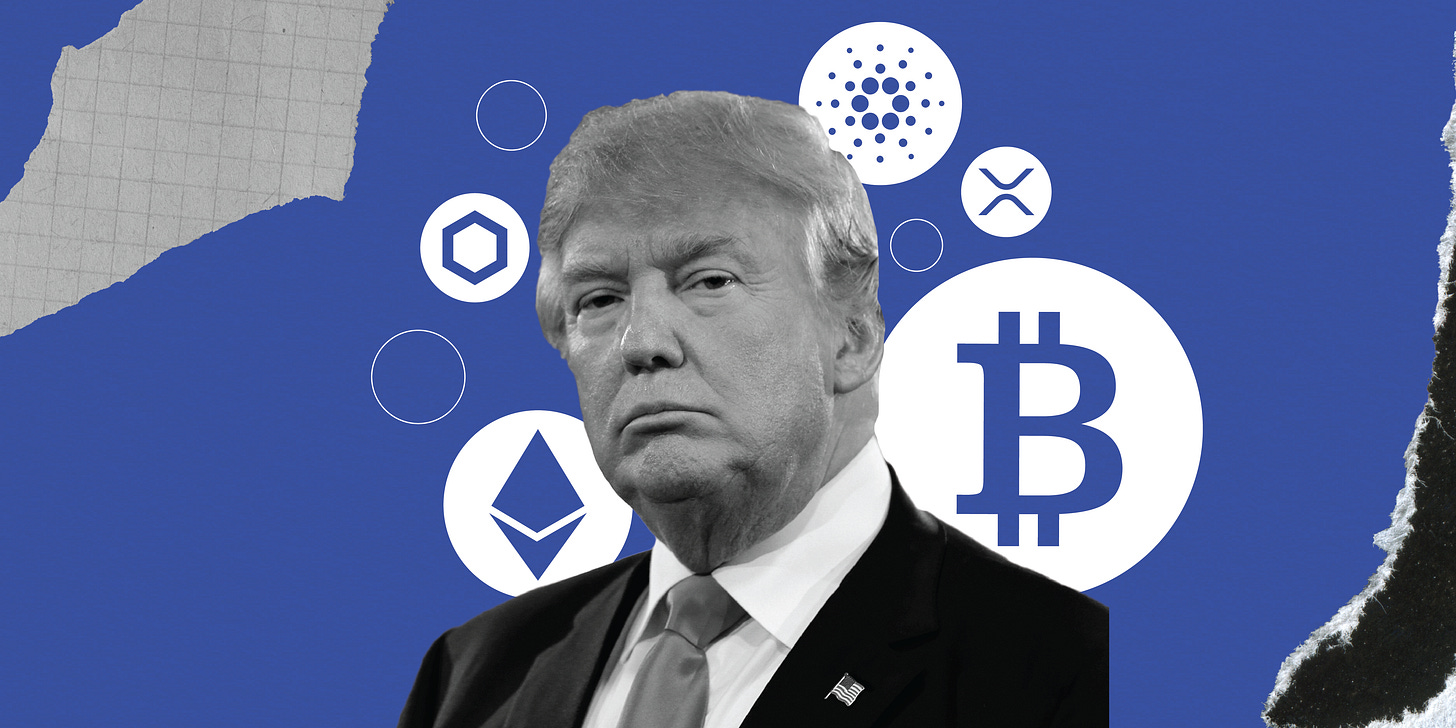Bitcoin: Suddenly, Then All At Once
Bitcoin breaks $123K as sentiment, policy, and fundamental positioning converge.
The Crypto Advisor is your trusted resource for navigating the world of cryptocurrency. Each week, we deliver a clear and concise update on the latest developments in crypto, straight to your inbox. This is more than just a newsletter; it’s an essential resource for forward-thinking advisors focused on maintaining a competitive edge. We’re excited to support your journey in adapting to and thriving in the new age of financial services.
Bitcoin: Suddenly, Then All At Once
Bitcoin’s price action is unlike that of any other financial asset in the world.
For months, this asset will oscillate within defined ranges, tiring out long-term holders and stopping out leveraged traders, to then suddenly and violently push through its previous ceiling far into price discovery.
They say if you miss the best five trading days each year in the S&P 500, you’ll miss out on the majority of that year’s gains. But with Bitcoin, it’s even more extreme - miss the best five hours, and you can miss out on most of the upside.
This price action is deterring for risk-averse investors and often reinforces the perception that Bitcoin is ‘too volatile’ to fit within a traditional portfolio. But for those who understand its market structure and long-term trajectory, that same volatility can present strategic entry points and outsized upside.
How we prefer to analyze Bitcoin’s price behavior isn’t by zooming in on last week, last month, or even last year - but by stepping back and viewing it through the lens of what’s known as “The Four-Year cycle.”
For those unfamiliar, Bitcoin’s price history has loosely followed a four-year cycle, anchored by a recurring event known as the halving. Approximately every four years, the number of new Bitcoins awarded to miners in each block is cut in half - an event hardcoded into the Bitcoin protocol.
This process reduces the rate at which new supply enters the market, creating a structural supply shock. Since Bitcoin’s total supply is capped at 21 million, each halving increases its scarcity at a time when demand typically remains steady or grows. The result is a supply-demand imbalance that has historically driven significant upward price pressure in the months - and often years - that follow.
Looking back at previous cycles, the impact of Bitcoin’s halving events becomes clearer when measured from each halving to the subsequent cycle top.
After the first halving in November 2012, Bitcoin rose from around $12 to over $1,100 - a gain of more than 9,000%.
The second halving in July 2016 saw Bitcoin climb from roughly $650 to nearly $20,000 by December 2017, marking an increase of around 3,000%.
Following the third halving in May 2020, Bitcoin surged from about $8,600 to an all-time high of $69,000 in November 2021, a rise of nearly 700%.
The fourth halving in April 2024 has so far seen Bitcoin rise from approximately $64,000 to a new cycle high of $123,000, marking a gain of about 92%.
They say history doesn’t repeat - but in nascent asset classes undergoing early adoption, it often rhymes. Bitcoin’s four-year cycle may not follow a perfectly predictable script, but its recurring structure offers a useful lens for understanding long-term market behavior and investor psychology.
Also key to note about Bitcoin’s price behavior is that the time from each halving to the subsequent cycle top has been lengthening - likely due to increasing market maturity, deeper liquidity, and the growing influence of institutional capital, all of which tend to dampen volatility and stretch out price discovery.
After the first halving in November 2012, it took roughly 12 months for Bitcoin to reach its cycle peak in late 2013.
The second halving in July 2016 saw Bitcoin top out approximately 17 months later, in December 2017.
Following the third halving in May 2020, Bitcoin reached its all-time high around 18 months later, in November 2021.
Price action since the fourth halving in April 2024 is still playing out, but as of July - 15 months later - Bitcoin has already posted a new cycle high of $123,000.
It’s becoming increasingly difficult to ignore the historical patterns Bitcoin continues to obey. Seasoned, long-term investors have grown comfortable with its volatility - because they’ve seen this behavior time-and-time again. The sharp drawdowns, explosive rallies, and periods of stagnation are all part of this asset’s natural cadence. To them, Bitcoin isn’t behaving unpredictably - it’s stretching and compressing in a way that mirrors its past cycles.
That said, Bitcoin remains a young asset by historical standards, especially when compared to others of similar scale. Yet despite its age, it now ranks as the sixth-largest asset in the world, currently sandwiched between Google below it and Amazon above it in total market value.
Being in that kind of company raises the stakes.
Our observation right now is that the biggest risk this cycle isn’t in the charts - it’s in the belief that Bitcoin’s growing global relevance, expanded institutional presence, and increasing macro exposure mean this time is entirely different.
And while we agree those observations are categorically correct, the conclusion doesn’t logically or historically follow.
Every cycle feels different - and in many ways, each one is. That sense of unpredictability is almost a requirement; it’s what gives Bitcoin its distinct atmosphere, continually surprising skeptics and reaffirming the conviction of long-term believers.
At the same time, we anticipate diminishing returns and lengthening cycles - all available data points to this reality. These are hallmarks of a maturing asset, not signs of weakness. In fact, they reflect healthy, sustainable growth as Bitcoin gradually secures its place in the global financial system.
Just remember - no matter how crazy things get, the name of the game remains the same: periods of accumulation, followed by expansion, euphoria, and, eventually, correction.
This past week was a clear reminder that missing even a handful of Bitcoin’s biggest days can dramatically impact long-term returns. In crypto, those days often compress into hours - we just witnessed a few of them.
For both advisors and investors, the message is simple. Bitcoin doesn’t wait for perfect conditions or widespread consensus. The market tends to move subtly… until it moves all at once. Staying thoughtfully allocated - especially during the quiet stretches when everything seems calm - is still the most reliable way to capture the moments that matter.
Trump Media Files for “Crypto Blue Chip” ETF
Trump Media & Technology Group, the company behind Truth Social and majority-owned by President Trump, has filed to launch a new crypto exchange-traded fund: the “Crypto Blue Chip” ETF. The proposed fund would directly hold a diversified basket of leading digital assets, including Bitcoin, Ethereum, Solana, XRP, and Cronos. Roughly 75% of the fund’s allocation would be in Bitcoin, with the rest split among other large-cap cryptocurrencies - some of which have yet to appear in U.S.-listed spot ETFs.
This marks the third ETF proposal from Trump Media, signaling the firm’s broader ambitions in the digital asset space. If approved, it would enter an increasingly crowded market for crypto ETFs, where investor appetite continues to grow. The move also adds a political dimension, as it comes amid renewed scrutiny over President Trump’s financial interests and vocal pro-crypto stance - especially as Bitcoin’s price has surged over 50% since October. For RIAs, the potential launch of this ETF underscores the ongoing mainstreaming of crypto, as well as the intertwining of policy, politics, and investment vehicles in the digital asset space.
Congress Repeals Controversial DeFi Tax Reporting Rule
In a significant policy reversal, the U.S. Treasury and IRS have officially scrapped a contentious rule that would have required decentralized crypto platforms - like decentralized finance protocols and non-custodial exchanges - to report user transaction data for tax purposes. Originally introduced through the 2021 Infrastructure Act, the “crypto broker” rule sought to expand the IRS’s reach by treating certain crypto participants like traditional financial brokers.
While the goal was greater transparency, the rule faced strong opposition from the crypto industry and policymakers alike, who argued that enforcing such a mandate on decentralized platforms was technically unworkable and threatened user privacy. After years of legal and political pushback, including a successful repeal effort led by Congress and signed by President Trump in April, the rule has now been formally removed from federal regulations. For RIAs, this development reinforces the complex regulatory landscape surrounding crypto - and underscores the importance of staying updated as digital asset policy continues to evolve.
Regulators Clear Banks to Hold Crypto Assets
The Federal Reserve, OCC, and FDIC have authorized U.S. banks to offer custody services for Bitcoin and other cryptocurrencies, allowing traditional financial institutions to securely hold digital assets on behalf of their customers. This move addresses growing institutional demand for trusted crypto custody solutions while ensuring banks comply with strict regulations, including cybersecurity, anti-money laundering, and fiduciary responsibilities. As the regulators explained, “Banking organizations may provide safekeeping for crypto-assets in a fiduciary or a nonfiduciary capacity,” with fiduciary custodians required to follow applicable federal and state laws.
Managing crypto custody requires specialized expertise in protecting cryptographic keys, preventing cyber threats, and conducting thorough risk assessments. Banks must also perform due diligence on any sub-custodians they use, ensuring strong internal controls and compliance with Bank Secrecy Act, AML, and Office of Foreign Assets Control requirements. For RIAs, this regulatory clarity signals that digital assets are becoming more integrated into traditional finance, backed by established risk and compliance frameworks, making them increasingly accessible for institutional investors.
Ongoing Wallet Security: Staying Vigilant
Setting up a wallet is just the beginning - maintaining proper crypto security requires ongoing attention. Wallet software needs regular updates to stay secure, which means periodically logging in to check for and install new releases. These updates should always be done directly through the official wallet interface. Never initiate an update from an email or external site, as these are often phishing attempts designed to compromise your wallet.
Phishing remains one of the most persistent and dangerous threats in the crypto space, even for investors who have taken the precaution of setting up offline wallets. These scams often take the form of emails, websites, or messages that impersonate legitimate platforms in an effort to steal login credentials or private keys. A successful phishing attempt can result in the irreversible loss of funds. The best defense is vigilance: avoid clicking on unsolicited links, and always verify the legitimacy of any communication by navigating directly to the official website or contacting support through trusted channels.
Disclaimer: The information provided by The Crypto Advisor is for educational and informational purposes only and does not constitute financial, investment, or legal advice. The Crypto Advisor is not a registered investment advisor, broker-dealer, or financial planner. Nothing in this email should be interpreted as a recommendation to buy, sell, or hold any financial instrument or investment. Always consult with a licensed financial professional before making any investment decisions.









